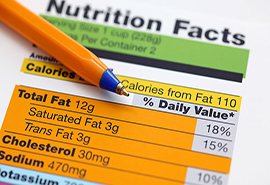
Food Labels
All packaged foods should come with a nutrition label to provide you with the necessary information that elucidates the details of what you are eating. It provides key information such as ingredients, serving size, calories, total fat, saturated fat, cholesterol, protein, carbohydrate and vitamin content. Learning how to read food labels and understanding the foods’ content helps you make healthier choices. Checking food labels also makes it easier for you to compare the nutrient content of different options and helps you find the foods that have the best nutritional value or the ones that are higher in vitamins and fiber but lower in fat, sodium, sugar or cholesterol.
Food labels content
- Nutrition Information Panel: this provides information on the amount of energy, protein, fat, carbohydrates and sodium (salt)
- Ingredient list: all of the ingredients contained in the food are listed in order of weight
- Food Additives: food additives, including colors, flavors and preservatives are included in the ingredient list in the form of numbers
- Country of Origin: any packaged food must state the country that the food was made or produced in
- Directions for use and storage: these include specific instructions such as “keep in cool and dry place” or “refrigerate after use”. These instructions help to maintain the safety and quality of the food
- Information for persons with food allergies: products containing the major allergens, peanuts, tree nuts, shellfish, milk, eggs, sesame, soybeans and gluten, are labeled as “may contain …” or “may contain traces of”
- Expiry and Manufacturing date: the expiry date helps you prevent consuming perished foods that might affect your health
Few tips
- Try to avoid choosing foods where sugar is one of the first few ingredients in the list. This means that the majority of the product is made with it
- If you are sensitive to a particular additive or allergic to one of the ingredients used, reading the food label will help you avoid the consumption of the food product
- Do not buy or consume foods after their “use-by” date. However, food is still safe for consumption after its “best before” date
- Be sure to check the serving size and how much you will actually eat. If a serving of biscuits is 2 biscuits, and you eat 6, this means you have consumed three times the calorie and nutrients amounts listed on the label
- Try to limit the consumption of total fat, cholesterol, sodium, and sugars. You can do so by searching for food products that contains a percentage daily value of 5% and lower
- Choose products that are high in dietary fiber, vitamins and minerals with a percentage daily value of 20% and above
- If you have high blood pressure, it is important to pay attention to the sodium content
- Avoid foods with trans-fat
- Keep in mind that the information shown in the nutrition facts is based on 2,000 calories a day. You may need to consume less or more than 2,000 calories depending on your age, gender, activity level, and whether you’re trying to lose, gain or maintain your weight
How to read food labels
- Serving size: refers to the measure of a single serving that provides the calories and the amounts of nutrients as listed in the nutrition facts
- Serving per container: refers to the number of servings found in the can, package, bottle or box
- Calories/ calories from fat: gives the total food energy per serving and calories from fat per serving
- Total fat: specifies the grams of fat per serving with a breakdown showing grams of saturated fat and trans-fat per serving
- Cholesterol: is specified in milligrams per serving
- Sodium: amount in milligrams per serving
- Total carbohydrates: grams of carbohydrates per serving, including starch, fiber and sugars
- Protein: refers to grams of protein per serving
- Vitamins and minerals: expressed as percentages of daily values in terms of a 2000 calorie diet
- The footnote is a reminder that all the percentages are based on the percent daily value of a 2000 calorie diet


